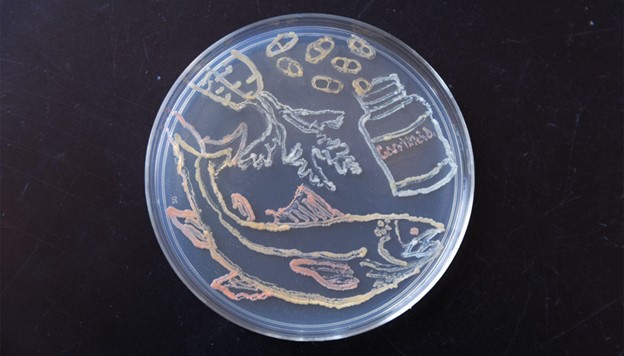For Sustainable Aviation Fuel, Researchers Engineer a Promising Microorganism for Precursor Production
Pseudomonas putida uses cheap plant biomass as a carbon source to make the precursor isoprenol.

The Science
Sustainable aviation fuels made from renewable sources of carbon could reduce carbon dioxide emissions and help to mitigate climate change. Isoprenol is a chemical involved in the production of a jet biofuel blendstock called 1,4-dimethylcyclooctane (DMCO). Blendstocks are chemicals that are combined with other chemicals to create fuel. Researchers have produced isoprenol in several microbial hosts. However, efforts to make sustainable aviation fuel would benefit if isoprenol could be made in microorganisms that use fermentable sugars from plant material as a source of carbon. The bacteria Pseudomonas putida (P. putida) could be such a microorganism, but it needs engineering to be an optimal choice. In this research, scientists used advanced computing tools to engineer P. putida for isoprenol production.
The Impact
Researchers used computational modeling to predict targets for gene editing and to optimize metabolism in P. putida to maximize the production of isoprenol. This approach allowed the researchers to select and prioritize gene editing targets and therefore to test a smaller number of engineered strains. They achieved the highest reported isoprenol production for P. putida. This is an important step toward a sustainable bioproduction process for jet fuel.
Summary
Researchers used a mixture of computational modeling and strain engineering to optimize isoprenol production in P. putida. They used multiple genome-scale metabolic model-based approaches to predict and prioritize gene knockout targets that would lead to increased isoprenol yields. This allowed them to reduce the number of targets they pursued. In addition, they applied known genetic edits to further improve isoprenol production and used proteomics to optimize the process.
The research achieved a 3.5 grams per liter isoprenol production titer, the highest reported for P. putida. The researchers concluded that their pathway optimization therefore resulted in a 10-fold improvement of isoprenol in P. putida. The researchers suggest additional improvements must be made to improve isoprenol yields for industrial applications. Commercial-scale production of isoprenol and DMCO at commercial scale still requires additional improvements such as the inclusion of CRISPR gene editing and other bioprocess technologies.
Contact
Taek Soon Lee
Joint BioEnergy Institute and Lawrence Berkeley National Laboratory
tslee@lbl.gov
Joonhoon Kim
Joint BioEnergy Institute and Pacific Northwest National Laboratory
joonhoon.kim@pnnl.gov
Funding
The research was funded by the Joint BioEnergy Institute supported by the Department of Energy Office of Science, Biological and Environmental Research Program.Publications
Banerjee, D., et al., Genome-scale and pathway engineering for the sustainable aviation fuel precursor isoprenol production in Pseudomonas putida. Metabolic Engineering 82, 157 (2024). [DOI: 10.1016/j.ymben.2024.02.004]
Highlight Categories
Performer: DOE Laboratory



